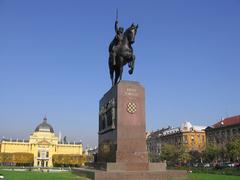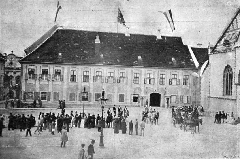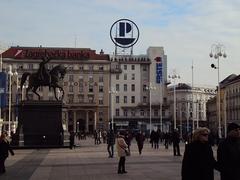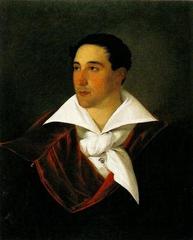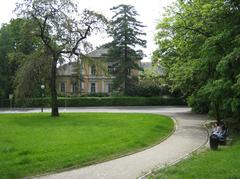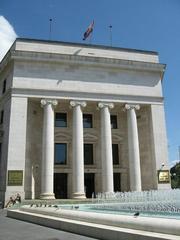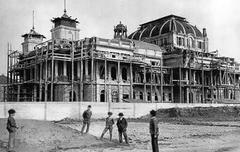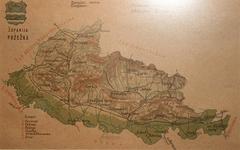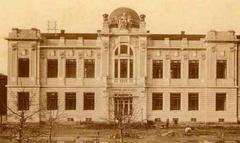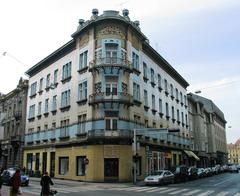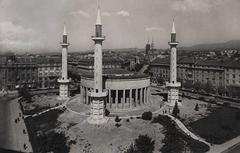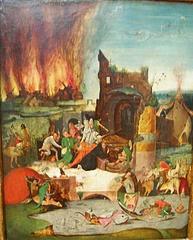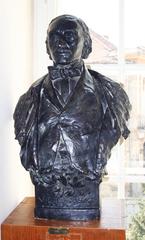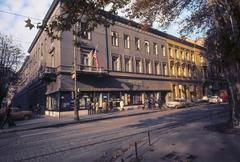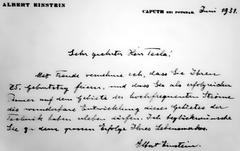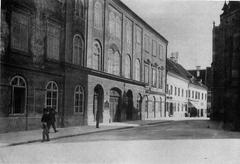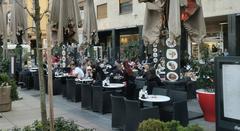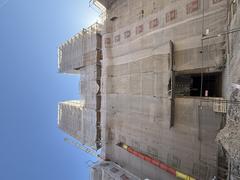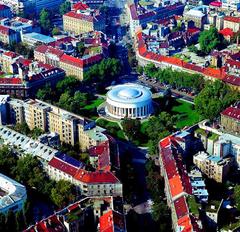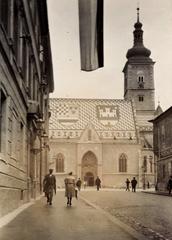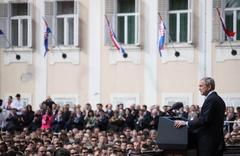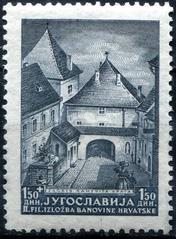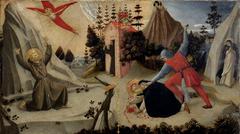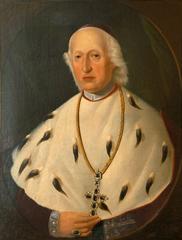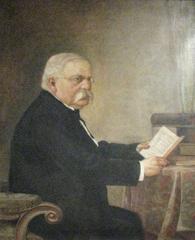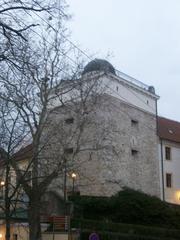Croatian Nobles Square, Zagreb: Visiting Hours, Tickets, and Travel Guide
Date: 14/06/2025
Introduction
Croatian Nobles Square (Trg hrvatskih velikana) is a distinguished urban landmark in Zagreb, Croatia, symbolizing the city’s transformation from a medieval town into a modern European capital. Characterized by its monumental architecture, rich political symbolism, and vital civic role, the square is a must-visit for history enthusiasts, architecture lovers, and travelers seeking to understand Zagreb’s cultural evolution. This comprehensive guide details its history, architectural highlights, visiting information, accessibility, and tips for making the most of your visit. (Everything.Explained.Today; Wikipedia; Lice Grada)
Table of Contents
- Introduction
- Historical Development and Urban Planning
- Architectural Highlights
- Political and Cultural Significance
- Urban Context and Connectivity
- Visitor Information
- Visuals and Media
- Frequently Asked Questions
- Summary and Recommendations
- References
Historical Development and Urban Planning
Until World War I, the area now occupied by Croatian Nobles Square served primarily as an undeveloped fairground on the eastern edge of Zagreb’s core. The 1923 urban regulatory plan launched its transformation, envisioning the square as a monumental gateway to Zagreb’s eastern expansion. This marked a significant shift in the city’s development, reflecting modern urban planning trends and Croatia’s broader aspirations for progress and modernization. The square’s location—between Draškovićeva Street and Martićeva Street, with tram routes and prominent roads—ensured its role as a key urban node and connector. (Wikipedia)
Architectural Highlights
Monumental Palaces
The square’s most defining features are its symmetrical monumental buildings, constructed in 1927:
- Former Stock Exchange Palace (Palača Burze): Designed by Viktor Kovačić, this neoclassical masterpiece now houses the Croatian National Bank. It is notable for its grand façade, imposing columns, and architectural balance.
- State Office for Croats Abroad: Situated opposite the National Bank, this building was designed by Aladar Baranyai and continues the monumental style, reflecting the square’s original symmetrical vision. (Everything.Explained.Today)
Modernist and Functionalist Structures
- Western Side: Features terraced four-story residential buildings by Bela Auer and Pavle Deutsch, exemplifying the shift from historicist to modernist trends in the late 1920s and early 1930s.
- Northern Edge: The Janeković building, designed by Hugo Ehrlich in 1928, further enriches the square’s architectural diversity.
- Post-War Addition: The “wooden skyscraper” (drveni neboder) by Drago Ibler, built between 1956 and 1958, stands out for its innovative use of materials and verticality.
Contemporary Features
- Triangular Fountains: Installed in 1995 and designed by Mihajlo Kranjc, these modern fountains add a refreshing and symbolic touch, representing Zagreb’s renewal in the post-independence era. (Lice Grada)
Political and Cultural Significance
Croatian Nobles Square embodies the evolving civic identity of Croatia. Its numerous name changes reflect the country’s complex political history:
- Trg Burze (Stock Exchange Square, 1928)
- Trg münchenskih žrtava (WWII era)
- Trg Jože Vlahovića (Socialist period)
- Trg Burze (1990)
- Trg hrvatskih velikana (since 2001)
The current name honors Croatia’s historical leaders and national heritage, especially following the country’s independence in 1991. The square houses major institutions such as the Croatian National Bank and the State Office for Croats Abroad, underscoring its central administrative and economic role. (Wikipedia)
Urban Context and Connectivity
Strategically located, Croatian Nobles Square connects major tram lines and streets, making it easily accessible and central to Zagreb’s urban flow. Its proximity to other significant landmarks—such as the Square of the Victims of Fascism, Lower Town (Donji Grad), and Dolac Market—makes it an ideal base for exploration. (Eupedia)
Visitor Information
Visiting Hours
- Open 24/7: Croatian Nobles Square is a public space accessible at all hours, year-round.
Tickets and Entrance Fees
- Free Admission: No tickets are required to enter the square. Note that access to the interiors of administrative buildings like the Croatian National Bank is restricted.
Accessibility
- Tram and Bus: The square is served by tram lines on Draškovićeva, Martićeva, and Račkoga streets, ensuring easy access.
- Wheelchair-Friendly: The square features smooth pavements and accessible paths for visitors with mobility challenges.
Guided Tours
- Available: Many local tour operators include the square in historical and architectural tours of Zagreb. Bookings can be made online or at tourist centers.
Nearby Attractions
- Square of the Victims of Fascism: A major memorial site, just a short walk away.
- Lower Town (Donji Grad): Museums, parks, and shopping in Zagreb’s central district.
- Zagreb Cathedral: The city’s iconic cathedral, easily reached by tram.
- Ban Jelačić Square: Zagreb’s main square and central hub.
Travel Tips
- Visit on weekdays for a quieter experience.
- Early morning or late afternoon light is ideal for photography.
- Combine your visit with a stroll along Jurišićeva Street or Dolac Market.
Visuals and Media
High-quality images and virtual tours of Croatian Nobles Square are available on official Zagreb tourism sites. Look for alt text such as “Croatian Nobles Square Zagreb architecture” or “Stock Exchange Palace Zagreb” for improved accessibility and SEO. Informative plaques around the square provide historical context, and interactive maps can help plan your visit. (Zagreb Tourist Board)
Frequently Asked Questions (FAQ)
Q: What are the visiting hours of Croatian Nobles Square?
A: The square is open to the public 24 hours a day.
Q: Is there an entrance fee or ticket required?
A: No, Croatian Nobles Square is freely accessible.
Q: Are guided tours available?
A: Yes, many guided walking tours include the square. Check with local operators or the tourist board.
Q: Is the square wheelchair accessible?
A: Yes, the square and surrounding streets are accessible for wheelchairs.
Q: How do I get there by public transport?
A: Take trams running through Draškovićeva, Martićeva, or Račkoga streets; nearest stops include Trg hrvatskih velikana and Trg žrtava fašizma.
Summary and Recommendations
Croatian Nobles Square is a testament to Zagreb’s layered history, political transformations, and architectural innovation. From its origins as a fairground to its development as a monumental urban gateway, it reflects Croatia’s 20th-century aspirations and modern identity. The square’s neoclassical and modernist architecture, vibrant public space, and central location make it a highlight for any visitor.
- Accessibility: Open 24/7, free admission, and well-served by public transport.
- Cultural Value: An excellent introduction to Zagreb’s urban development and national history.
- Tourist Experience: Ideal for photography, guided walks, and exploring Zagreb’s broader cultural landscape.
Plan your visit today to Croatian Nobles Square, and discover the heart of Zagreb’s architectural and historical story. For personalized tours, event updates, and insider tips, download the Audiala app and follow our social media for the latest news.
References
- Everything.Explained.Today – Croatian Nobles Square
- Wikipedia – Croatian Nobles Square
- Lice Grada – Povijest, arhitektura i sva imena Trga hrvatskih velikana
- Eupedia – Zagreb
- Zagreb Tourist Board

